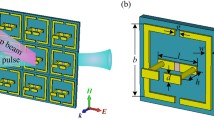Abstract
The coupling between plasmonic modes and lattice diffraction modes of circular split-ring resonators in terahertz (THz) region has been analyzed by changing the lattice constants. We discovered a blue shift of the individual eigenmode in short lattice constants, which is due to the longitudinal coupling of two adjacent eigenmodes from neighboring unit cells. We found an anti-crossing effect in long lattice constants for both TM and TE incidence as the lattice diffraction modes is fused with the plasmonic modes to form hybrid modes. Moreover, these hybrid modes are more sensitive to the refractive index change than the pure modes, which shows the promise to increase the sensitivity of metamaterials by coupling.









Similar content being viewed by others
References
Lan C et al (2013) Hyperbolic metamaterial based on anisotropic Mie-type resonance. Opt Express 21(24):29592–29600
Zheludev NI (2008) What diffraction limit? Nat Mater 7(6):420–422
Rockstuhl C et al (2006) On the reinterpretation of resonances in split-ring-resonators at normal incidence. Opt Express 14(19):8827–8836
Petschulat J et al (2009) Multipole nonlinearity of metamaterials. Phys Rev A 80(6):063828
Giannini V, Vecchi G, Rivas JG (2010) Lighting up multipolar surface plasmon polaritons by collective resonances in arrays of nanoantennas. Phys Rev Lett 105(26):266801
Prodan E et al (2003) A hybridization model for the plasmon response of complex nanostructures. Science 302(5644):419–422
Liu N, Giessen H (2010) Coupling effects in optical metamaterials. Angew Chem Int Ed 49(51):9838–9852
Zou S, Janel N, Schatz GC (2004) Silver nanoparticle array structures that produce remarkably narrow plasmon lineshapes. J Chem Phys 120(23):10871–10875
Al-Naib I et al (2014) Conductive coupling of split ring resonators: a path to THz metamaterials with ultrasharp resonances. Phys Rev Lett 112(18):183903
Çetin AE et al (2011) Plasmon induced transparency in cascaded π-shaped metamaterials. Opt Express 19(23):22607–22618
Huang Y et al (2015) Coupling tai chi chiral metamaterials with strong optical activity in terahertz region. Plasmonics 10(4):1005–1011
Huang Y et al (2016) Manipulating Magnetoinductive coupling with graphene-based plasmonic metamaterials in THz region. Plasmonics 11(4):963–970
Ameling R, Giessen H (2013) Microcavity plasmonics: strong coupling of photonic cavities and plasmons. Laser Photonics Rev 7(2):141–169
Zhang S et al (2011) Substrate-induced Fano resonances of a plasmonic nanocube: a route to increased-sensitivity localized surface plasmon resonance sensors revealed. Nano Lett 11(4):1657–1663
Liu J et al (2013) Double plasmon-induced transparency in hybrid waveguide-plasmon system and its application for localized plasmon resonance sensing with high figure of merit. Plasmonics 8(2):995–1001
Bitzer A et al (2009) Lattice modes mediate radiative coupling in metamaterial arrays. Opt Express 17(24):22108–22113
Christ A et al (2003) Waveguide-plasmon polaritons: strong coupling of photonic and electronic resonances in a metallic photonic crystal slab. Phys Rev Lett 91(18):183901
Liu H et al (2012) Controllable coupling of localized and propagating surface plasmons to Tamm plasmons. Plasmonics 7(4):749–754
Wu X et al (2013) Sensing self-assembled alkanethiols by differential transmission interrogation with terahertz metamaterials. Appl Opt 52(20):4877–4883
Wu X et al (2013) Self-referenced sensing based on terahertz metamaterial for aqueous solutions. Appl Phys Lett 102(15):151109
Xie L et al (2015) Extraordinary sensitivity enhancement by metasurfaces in terahertz detection of antibiotics. Sci Rep 5:8671
Wu X et al (2013) Alkanethiol-functionalized terahertz metamaterial as label-free, highly-sensitive and specificbiosensor. Biosens Bioelectron 42:626–631
Fangrong Hu LW, Quan B, Xu X, Li Z, Pan ZAX (2013) Design of a polarization insensitive multiband terahertz metamaterial absorber. J Phys D Appl Phys 46:195103
Fedotov V et al (2007) Sharp trapped-mode resonances in planar metamaterials with a broken structural symmetry. Phys Rev Lett 99(14):147401
Homola J, Koudela I, Yee SS (1999) Surface plasmon resonance sensors based on diffraction gratings and prism couplers: sensitivity comparison. Sensors Actuators B Chem 54(1–2):16–24
Homola J, Yee SS, Gauglitz G (1999) Surface plasmon resonance sensors: review. Sensors Actuators B Chem 54(1–2):3–15
Yu F et al (2004) Surface plasmon enhanced diffraction for label-free biosensing. Anal Chem 76(13):3530–3535
Lubin SM et al (2013) Quasiperiodic Moiré plasmonic crystals. ACS Nano 7(12):11035–11042
Zentgraf T et al (2009) Ultranarrow coupling-induced transparency bands in hybrid plasmonic systems. Phys Rev B 80(19):195415
Shelton DJ et al (2011) Strong coupling between nanoscale metamaterials and phonons. Nano Lett 11(5):2104–2108
Xu X et al (2011) Flexible visible–infrared metamaterials and their applications in highly sensitive chemical and biological sensing. Nano Lett 11(8):3232–3238
Jepsen PU, Jensen JK, Møller U (2008) Characterization of aqueous alcohol solutions in bottles with THz reflection spectroscopy. Opt Express 16(13):9318–9331
Na Liu, MM, Weiss T, Hentschel M, Giessen H (2010) Infrared perfect absorber and its application as plasmonic sensor. Nano Lett 10:2342–2348
Becker J et al (2010) The optimal aspect ratio of gold nanorods for plasmonic bio-sensing. Plasmonics 5(2):161–167
Acknowledgements
This work was supported by National Natural Science Foundation of China (No. 11374240) and Guangxi Key Laboratory of Automatic Detecting Technology and Instruments (YQ17201).
Author information
Authors and Affiliations
Corresponding author
Rights and permissions
About this article
Cite this article
Yu, L., Wang, Q., Hu, F. et al. Coupling Between Metamolecular Modes and Lattice Diffraction Modes of Metamaterials in Terahertz Region. Plasmonics 13, 961–969 (2018). https://doi.org/10.1007/s11468-017-0594-1
Received:
Accepted:
Published:
Issue Date:
DOI: https://doi.org/10.1007/s11468-017-0594-1




